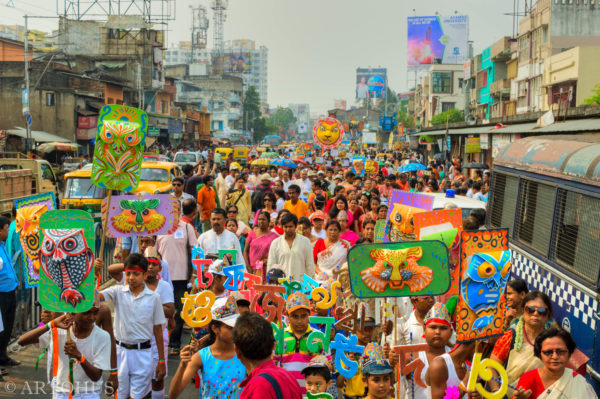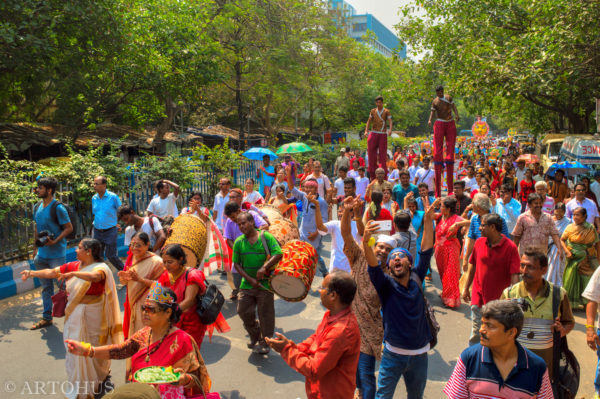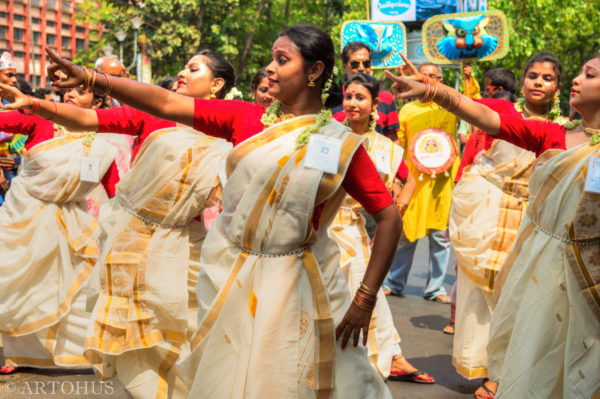by ARTOHUS
April is one of the best times to be in India. It’s when the winter quietly gives way to spring and ushers New Year across the country. Astronomically, the sun moves into the Makara (Capricorn) position, marking the end of the winter solstice and heralding the onset of several harvest festivals across various states. Punjab welcomes it as Vaisakhi, Assam as Rongali Bihu, Odisha as Pana Sankranti, Kerala as Vishu and Tamil Nadu as Puthandu.
In West Bengal, it is Poila (first) Baisakh. The date more or less falls on the 14th of April according to the Gregorian calendar, marking the first day of the month of Baisakh for Bengalis. The origin of the Bengali calendar is ambiguous though. Popular theories suggest that during Mughal rule, Akbar started the Bengali year called Bangabda by combining the solar and lunar calendars to appoint the time of tax collection. This is disputed, however, because the term Bangabda has been found in several temples to Shiva even before Akbar’s rule. It was known as FasholiShan or harvest calendar. However, an alternate theory argues that it was Nawab Murshid Quli Khan, the first Nawab of Bengal, who started the Bengali calendar with the tradition of Punyaho or tax collection day. Another theory equates King Shashanka of the 7th century to the Bengali calendar.
Despite the disputed history, Poila Baisakh is celebrated with pomp and show among Bengalis in Dhaka, Tripura, West Bengal and other parts of the world. Kolkata wakes up to melodies of Rabindra Sangeet floating in the morning air. The city unravels its new avatar while its residents unveil new clothes bought for the special occasion. Young ones touch the feet of their elders, as is the traditional custom, and seek blessings for the upcoming year. Book shops stock themselves with the Bengali Panjika or almanac. The long red book is akin to Yellow Pages for Bengalis, containing a list of all auspicious days of the year for marriages, grihapabesh (housewarming ceremony), upanayana (thread ceremony), initiation of a business etc.
Poila Boisakh also marks the beginning of the accounting day for Bengali traders and shop owners. The businessmen open a new accounting ledger known as Haal Khata on this day, and offer pujas at the temples of Kalighat and Dakshineshwar. A formal ceremony is organised in the evenings where Lord Ganesha and Goddess Lakshmi are worshipped and invitations are sent to customers for the ceremony. Local shops distribute boxes of sweets among members of the locality.
One of the spectacular aspects of Poila Baisakh celebrations in Dhaka is the historical Mangal Shobhajatra, initiated in 1985, where a massive procession hits the streets at dawn and the scene becomes a riot of colours and a rich intermingling of culture, heritage and festivities. Inspired by this, India hosted its first Mangal Shobhajatra in Kolkata this year, albeit on a smaller scale, to celebrate Poila Baisakh. The procession commenced from Ganguly Bagan and culminated at Jadavpur University.
Being close to my home, I was witness to the historic procession. Reaching there early morning on the day of the procession, I found the usual leisurely street completely transformed. The street was abuzz with people and the quotidian quiet morning air replaced with festive fervour. Little kids in colourful clothes stood holding thermocol cut-outs of Bengali letters. Behind them were men and women in their traditional pajama-panjabi (kurta and trousers) and lal-paar (red-bordered) sari carrying masks and parasols. Surrounding them were photographers and media personnel covering the event. Above them, neighbours peeked from their balconies to observe the proceedings.
Two men on stilts arrived wading through the crowd like giants. It was a spectacular sight to see the roads that you mostly see in shades of grey transform into a sea of sundry colours. The dhakis (drum players) had arrived too and with their playing, the festivities began. The crowd started walking through the familiar streets. The organisers, perched on a moving truck, addressed the crowd and thanked them for being a part of the historic procession that reflected the rich heritage of Bengal.
Soon the vivacious beats of dhaks took over and people started gyrating to it. The men on stilts too did a jig atop the poles. Loud cheers came from the crowd, frenzy with joy, inattentive to the sweltering heat. Colourful masks and parasols bobbed their heads from the carpet of people draping the street. Being early morning, the traffic was less. However, the streets were filled with onlookers and passersby who stopped to behold the grand procession on its way. Some took pictures and filmed videos.
The 3-kilometre march paused in between for refreshments. Glasses full of Glucon-D were handed over to the revellers which rejuvenated their spirits and the procession regained in full force.
At the crossing near Jadavpur University, people gathered to admire a huge alpana (colourful motif made of a paste of rice and flour drawn with hand) painted on the road. Nearing their destination, the enthusiasm of the crowd redoubled and they started cheering with even more gusto. A group of young girls in traditional saris danced to the tunes of Banglar Mati, Banglar Jal, penned by the quintessential bard, Rabindranath Tagore. Upon reaching the final destination, the procession gave way to a second segment of festivities. Singers, artists and school children performed song and dance at the venue throughout the rest of the morning in the exhilaration of embracing the new.
As the morning ended, I felt mesmerised to think I was a part of this iconic celebration. It made me realise how festivals had a way of uniting people without any barriers, spreading joy and happiness in their wake. A mixed feeling of pride, elation and warmth gripped me since it wasn’t a morning when we just welcomed the New Year but also one when we created history.









